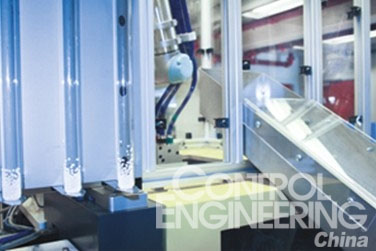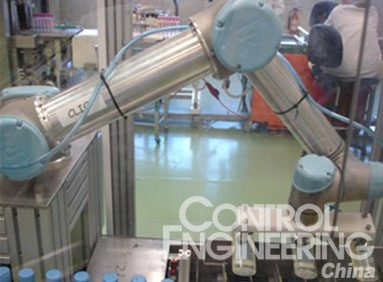When asked how they envision what robots might look like, most people think of large, hulking robots working in fenced areas of large factories, or futuristic armored warriors that mimic human behavior.
In between, however, a new phenomenon is quietly emerging: the emergence of so-called "cobots", which can work directly side by side with human employees without the need for safety fences to isolate them. This type of cobot can hopefully bridge the gap between fully manual assembly lines and fully automated ones. So far, some companies, especially SMEs, still think robotic automation is too expensive and complicated, so they never consider the possibility of application.
Traditional industrial robots are generally bulky, work behind glass shields, and are widely used in the automotive industry and other large assembly lines. In contrast, cobots are lightweight, highly flexible, mobile, and can be reprogrammed to solve new tasks, helping companies adapt to more advanced low-volume machining production to meet the challenges of short-run production. In the United States, the number of robots used in the automotive industry still accounts for about 65% of the total market sales. The American Robot Industry Association (RIA), citing observer data, believes that among companies that may benefit from robots, only 10% of companies have installed robots so far.

Hearing aid maker Odicon uses UR5 robotic arms to perform various tasks in the foundry, while suction tools have been replaced with pneumatic clamps that can handle more complex castings. The six-axis robot has a cycle of four to seven seconds and can perform rollover and tilting operations that are not possible with conventional Two - and three-axis Odicon robots.
Precise handling
The traditional robots used by Audi could not solve problems related to applicability and portability. But with the new robots, it all goes away. The parts of modern hearing AIDS are getting smaller and smaller, often measuring only one millimeter. Hearing aid makers have been looking for a solution that can suck small parts out of molds. This is completely impossible to do manually. Similarly, "old" two - or three-axis robots, which can only move horizontally and vertically, cannot be achieved. If, for example, a small part gets stuck in a mold, the robot has to be able to flip it out.
In just one day, Audicon installed robots in its molding workshop for new tasks. The new robot can be securely mounted on top of an injection molding machine's mold, drawing plastic components through a specially designed vacuum system, while more complex molded parts are handled using pneumatic clamps. Thanks to its six-axis design, the new robot is highly maneuverable and can quickly remove parts from the mold by rotating or tilting. The new robots have a working cycle of four to seven seconds, depending on the size of the production run and the size of the components. Due to the optimized production process, the payback period is only 60 days.

At the Audi Factory, the UR robot is firmly mounted on an injection molding machine and can move over molds and pick up plastic components. This is done using a specially designed vacuum system to ensure that sensitive components are not damaged.
Can work in limited space
At The Italian Cascina Italia plant, a collaborative robot working on a packaging line can process 15,000 eggs an hour. Equipped with pneumatic clamps, the robot can complete the packing operation of 10 egg cartons. The job requires very precise handling and careful placement, as each egg box contains 9 layers of 10 egg trays.
Initially, Cascina did not expect to use the robots to do the work, but the egg company quickly realized the benefits of using the robots after seeing them in action at its own factory. Ninety days later, the new robots are working on factory lines. Weighing just 11 pounds, the robot can move easily from one packaging line to another, which is crucial for Cascina, which has four different sizes of egg products and needs the robot to be able to work ina very limited space next to human employees.

Cascina Italia uses The UR5 robot from UAO Robotics to process 15,000 eggs an hour on its automated packaging line. Company employees can quickly reprogram the robot and work next to it without using a security fence. Because the Cascina plant was not planned to house a single robotic automation unit, a portable robot that can move quickly between tasks was crucial for the Italian egg distributor.
Safety first
For a long time, safety has been the hot spot and main driving force of robot laboratory research and development. Considering the safety of working with humans, the new generation of industrial robots consists of spherical joints, reverse-driven motors, force sensors and lighter materials.
The Cascina plant's robots comply with existing safety requirements on force and torque limits. When they come into contact with human employees, the robots are equipped with force control devices that limit the force of the touch to prevent injury. In most applications, after a risk assessment, this safety feature allows the robot to operate without the need for safety protection.
Avoid heavy labor
At the Scandinavian Tobacco Company, collaborative robots can now work directly side by side with human employees to cap Tobacco cans on Tobacco packaging devices.

At Scandinavian tobacco, the UR5 robot now loads cans of tobacco, freeing employees from repetitive drudgery and transferring them to lighter jobs. Youao Robot company's new mechanical arm products are well received by everyone.
New robots can replace human workers in heavy repetitive tasks, freeing up one or two workers who previously had to do the job by hand. Those employees have now been reassigned to other positions in the plant. Since there is not enough room on the packaging unit in the factory to isolate the robots, deploying collaborative robots greatly simplifies the installation and reduces costs.
Scandinavian tobacco developed its own fixture and arranged for in-house technicians to complete initial programming. This protects enterprise know-how, ensures high productivity, and avoids production downtime, as well as the need for expensive outsourcing consultants in the event of an automation solution failure. The realisation of optimised production has led business owners to decide to keep production in Scandinavian countries where wages are high. The tobacco company's new robots have a return on investment period of 330 days.
From 45 bottles per minute to 70 bottles per minute
Big manufacturers could also benefit from new robots. At a Johnson & Johnson factory in Athens, Greece, collaborative robots have significantly optimized the packaging process for hair and skin care products. Working around the clock, the robotic arm can pick up three bottles of product from the production line at the same time every 2.5 seconds, Orient them and place them inside the packaging machine. Manual processing can reach 45 bottles per minute, compared with 70 products per minute with robot-assisted production.

At Johnson & Johnson, employees love working with their new collaborative robot colleagues so much they have a name for it. UR5 is now affectionately known as "Cleo".
The bottles are vacuumed up and safely transferred without any risk of scratching or slipping. The robot's dexterity is crucial because the bottles come in all shapes and sizes and the labels are not printed on the same side of all the products, meaning the robot must be able to grip the product from both the right and left sides.
Any J&J employee can reprogram the robots to perform new tasks, saving the company the cost of hiring outsourced programmers.
A new direction in the development of robotics
These are some examples of how a new generation of robots has successfully tackled real-world challenges that traditional robots have failed to solve in the past. When it comes to the flexibility of human collaboration and production, the capabilities of traditional industrial robots must be upgraded at almost every level: From fixed installation to relocatable, from periodically repetitive tasks to frequently changing tasks, from intermittent to continuous connections, from no human interaction to frequent collaboration with workers, from space isolation to space sharing, and from years of profitability to near-immediate return on investment. In the near future, there will be many new developments in the emerging field of robotics that will constantly change the way we work and interact with technology.
Scandinavian tobacco developed its own fixture and arranged for in-house technicians to complete initial programming. This protects enterprise know-how, ensures high productivity, and avoids production downtime, as well as the need for expensive outsourcing consultants in the event of an automation solution failure. The realisation of optimised production has led business owners to decide to keep production in Scandinavian countries where wages are high. The tobacco company's new robots have a return on investment period of 330 days.
From 45 bottles per minute to 70 bottles per minute
Big manufacturers could also benefit from new robots. At a Johnson & Johnson factory in Athens, Greece, collaborative robots have significantly optimized the packaging process for hair and skin care products. Working around the clock, the robotic arm can pick up three bottles of product from the production line at the same time every 2.5 seconds, Orient them and place them inside the packaging machine. Manual processing can reach 45 bottles per minute, compared with 70 products per minute with robot-assisted production.
Post time: Apr-25-2022
